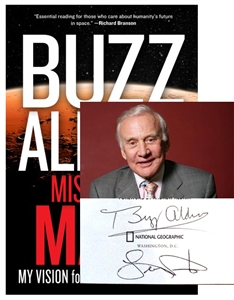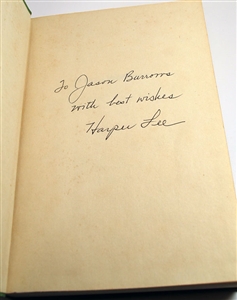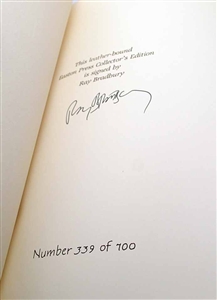When it comes to the world of book collecting, signatures can help or hurt the value of any given book.
Ever wonder what all the “signed by the author” fuss is about? Or why it isn’t wise to have your collectible rare book signed “Merry Christmas, Love Jimmy” on the title page? Here’s a primer to help you keep all these different kinds of signed books straight.
Signed Copy

A signed book is one that is truly signed by the author (or illustrator, or editor) for the purposes of making that copy special. These copies are almost always more valuable than their unsigned fellow editions, particularly when the signature is dated – and when that date is near to the publication date.
Best case scenario, for a book published January 15, 1950, would be a book signed (sometimes referred to as “flat-signed”) by the author on, say, January 20th or so.
Bookplate

Bookplates are often signed by the author, but separately from the book. The publisher would affix the bookplate to the book after the fact. Although the author’s signature still increases the value of the copy in question, a bookplate signature is worth less than a signature directly in the book.
Understanding Bookplates and How They Affect Book Value
Inscription
An inscription is a bit trickier. This means the copy has been signed by the author, but personally, i.e. to another person. If the book is inscribed to Tilly, and your name happens to be Bob, you might think this decreases the value of your book, rather than increasing it. But if it happens to be inscribed “To my dearest Tilly…” and amble on for lines and lines of lovingly scrawled text, that just means the author spent more time holding that book, really personalizing it – albeit for someone else. This might make the copy more valuable, even for you, Bob.
And furthermore, if Tilly happens to be some person very close to the author, this will absolutely increase the value to the collector. So never turn your nose up at an inscription without doing a bit of research. You never know when Tilly might make your copy priceless.
 Association and Dedication
Association and Dedication
If Tilly happens to be a famous author as well, then this inscription makes the book an “association copy” and therefore even more valuable. Multiply that to the nth degree if Tilly turns out to be the person to whom the book is dedicated. That is the Holy Grail of inscriptions: the dedication to the dedicatee. Never let one of these slip through your grasp.
Imposters Beware
Sometimes a signature isn’t really a signature, but a facsimile thereof. Publishers sometimes reproduce an author’s autograph into a stamp or press, and even the most experienced collectors can sometimes be fooled that it is real. Look out for uniformity of ink (real signatures tend to vary in color and thickness) and perhaps even try to feel the signature itself with your fingertips. A real signature may make an impression in the page itself. A fraud will feel completely flat or level with the paper. Under a magnifying glass, a fraud will also appear to be composed of many tiny dots (from the printing process).
Other Detractors
Other signature types can detract from the value of a book. These are signatures of ownership, i.e. “Bob’s Book. Xmas 1958” and gift inscriptions (when not ‘from’ or ‘to’ someone who would qualify as an associate or dedicatee).
Autograph Collecting
Once you have the basics down, you’ll want to be able to tell the difference between editions, not just signatures. Here’s a little glossary to help you along your way:
SIGNED LIMITED EDITION: Limited edition books are those that were released in a small print quantity, or “run.” Usually 1000 or so. These may be numbered, or lettered, so all copies may be accounted for. No other copies will be printed by the publisher with that exact cover design and treatment. These are usually more valuable than copies from larger runs. Sometimes, these more scarce editions are signed by the author, illustrator, or editor in the interest of making them more valuable collectibles.
DOUBLE SIGNED LIMITED EDITION: Think your signed limited edition copy of Moby Dick is valuable? It certainly is. But imagine if Melville had taken it upon himself to autograph one of these? That would mean you had two examples of his signature in one copy. That copy would thereby be doubly valuable.
SIGNED LETTERED EDITION: These books are much more valuable than their limited edition equivalents. These print runs are also much smaller, sometimes 52 or as few as 26 copies. And each book includes a sheet signed by the author (certified authentic), a slipcase or clamshell, and sometimes even additional material not available in the trade edition. These are often the most rare and sought-after collectible copies of a book.

SIGNED FIRST EDITION: Collectors and publishers differ on what constitutes a “first edition,” with publishers being concerned with the typeset and content, and collectors with the parameters of the first print run. First Editions are usually the first commercial publication of a book. A signed one of these is almost always extremely valuable.
Signed First Editions: A Collector’s Crown Jewel



Leave a Reply